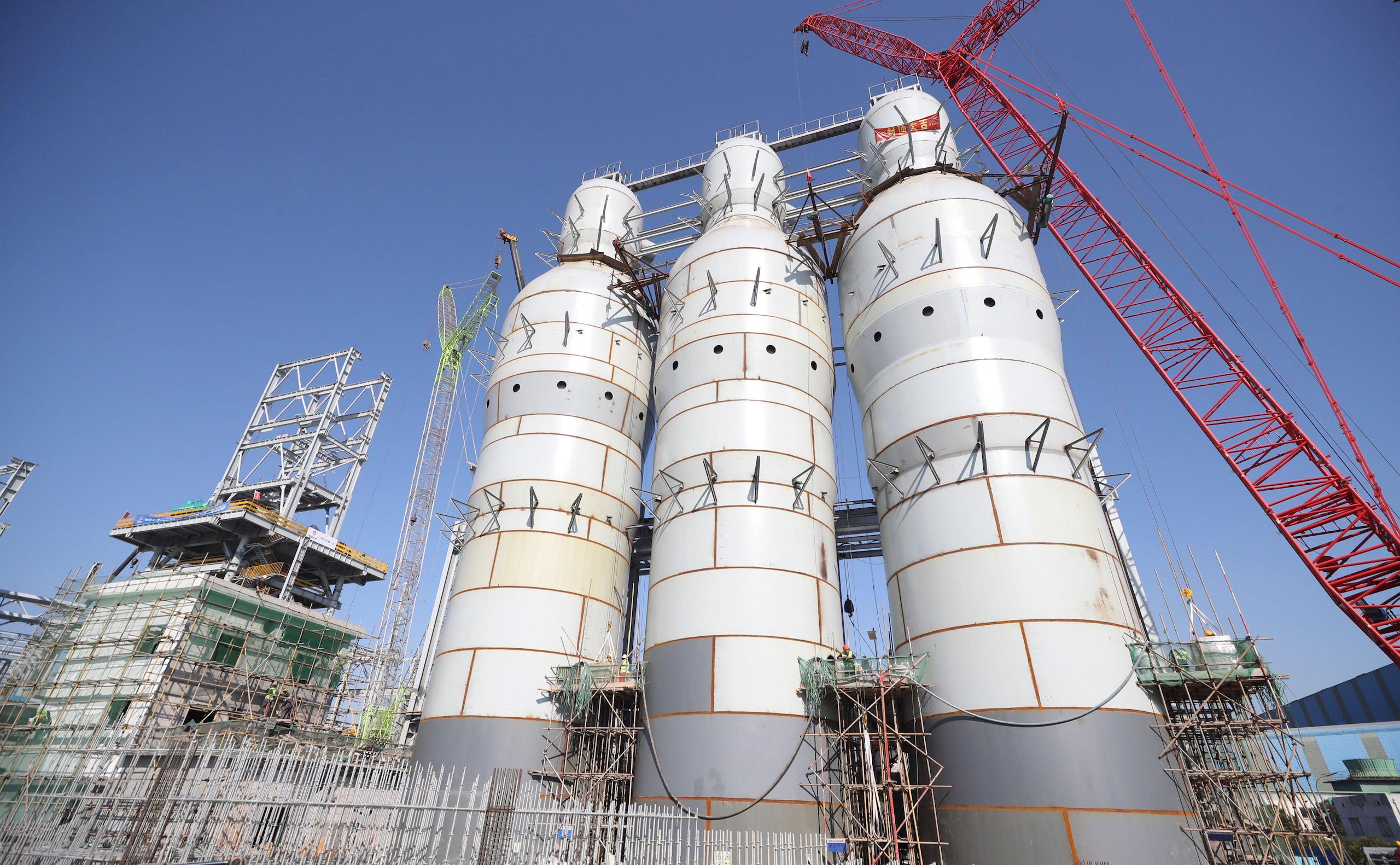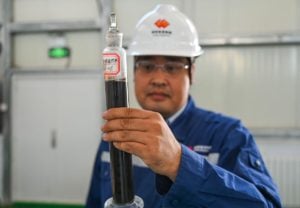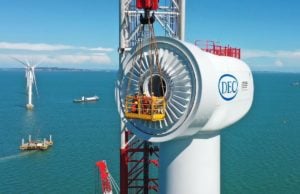China has seen a great deal of progress on low-carbon transitions in industry over the past decade. As a result, energy consumed per unit of GDP, known as “energy intensity”, fell by over 26% between 2012 and 2022, according to National Bureau of Statistics data.
A total of 2 trillion yuan (US$280 billion) of public and private capital has been invested in industrial energy-saving to date, the bureau data states. This has avoided the use of the equivalent of 400 million tonnes of coal, and comprised about 30% of all China’s energy savings in 2012-2022.
Funding has been crucial to these industrial transitions. Most of the cash comes from the private sector, with only 5-10% invested by the government, according to the China Energy Efficiency Financing and Investment Report, an unpublished study shared in a research group I participate in. This is particularly the case at the most important stage, research and development (R&D), which companies largely self fund.
By our calculations, a low-carbon transition for Chinese industry will need over 20 trillion yuan ($2.8 trillion) of funding between now and 2060. Clearly, government and banks alone will not be able to fund the various companies, projects and technologies in need of cash.
I believe that venture capital (VC) and private equity (PE) investors are still taking a cautious approach to low-carbon tech – and that there’s room for them to do more. VC and PE investors have varied opportunities to participate in Chinese industry’s low-carbon transition, and can learn from the experiences of other countries.
Supporting R&D: A key opportunity
Small and medium-sized enterprises (SMEs) are currently the biggest innovators in low-carbon tech in China. Their contribution to overall innovation and economic development – from bamboo composite pipes for plumbing, to wastewater-heat recovery – should not be overlooked. But, that high-risk, high-reward process is technologically challenging and expensive, so those firms often face severe funding constraints.
VC and PE investors, meanwhile, are tolerant of risk and long investment cycles. The contractual arrangements, phased capital investment and long-term targets typical of such investment all help to reduce risk for the investor. The financial products that arise from VC and PE are also diverse and flexible, providing long-term funding to achieve the national goal of a low-carbon transition, improve coordination along the supply chain and promote the application of R&D findings. Such investors can also help companies by providing accountancy and management support, improving governance, and accessing benefits from government policies – all of which will improve market competitiveness.
The industrial low-carbon transition is a secure, long-term and wide-ranging investment track. VC and PE investors have already dipped their toes in the water. For example, funding for hydrogen-energy-related companies had reached nearly 22 billion yuan (US$3.1 billion) by the end of 2022, according to research supported by Zero2IPO Group. Also seeing investment is recovery and reuse of recyclables, and the Industrial Internet of Things (IIoT) – which uses sensors and other networked devices to enhance manufacturing processes.
There are six key areas I believe VC and PE investors could focus on to boost the industrial transition:
1. Recycling
Namely, the recycling of waste steel, aluminium, plastic and paper products; recycling, utilisation and disposal of energy products like EV batteries, wind turbine blades and solar panels; and application of the Internet+ model. (Approximately 2.6 trillion yuan of investment is needed here to reach carbon neutrality, according to the sustainability organisation RMI.)
2. Electrification
Electrification of industrial heating systems; and electrification and innovation in core manufacturing processes in the steel, building materials, chemicals and nonferrous metals sectors. (This will require several trillion yuan, according to our research.)
3. Energy efficiency
Industrial energy-saving and energy-efficiency measures, including: efficiency improvements for equipment; sector coupling and system improvements; digitalisation to improve energy efficiency; and the application of energy-saving tech in industrial processes. (Investment of 1.08 trillion yuan is required in 2021-2025, according to our analysis.)
What is ‘sector coupling’?
🔗 Sector coupling means integrating industrial sectors in order to maximise use of resources.
🏭 For example, the chemical industry produces hydrogen and methane as by-products. The hydrogen can be used as energy or raw material in iron and steel production. While the methane can be used as fuel for cement production.
4. Hydrogen
Research, development and application of hydrogen as a substitute for carbon in metal refining; technology for manufacturing hydrogen electrolysis equipment; and new materials technology.
5. Digitalisation
Digitalisation of industrial companies, particularly SMEs. It is expected that the scale of China’s industrial digital economy will exceed 80 trillion yuan by 2032.
6. Carbon capture
Investment in applying and reducing the cost of carbon capture and storage tech for steel furnaces and cement kilns; utilisation of iron and steel slag; and recycling of CO2 from furnaces.
Standards and management: Two big challenges
VC and PE investments have seen significant successes in China. There have been improvements in levels of investment activity, market scale, and green investment, and a 9% increase in VC and PEs implementing ESG practices in 2021 compared with 2019. But problems remain.
One is a lack of adequate systems for defining, assessing and standardising “low-carbon tech”. Work on low-carbon industrial taxonomies is also lagging, with a failure to update and replace existing documents. For example, the China Energy-Saving Technology Policy Outline (2006) hasn’t been updated for almost two decades, and therefore does not help encourage investment.
Without those standards, third-party assessors cannot quantify the environmental benefits of such tech. This makes certification, assessment and identification of green technologies more expensive as technical appraisal are required to dispel investment concerns, increasing time and labour costs. Additionally, arrangement for the protection and licensing of green intellectual property, such as green patents, and associated services, are not yet fully in place. This is particularly the case for high-value patents, leading to investors avoiding involvement in the riskier pilot-testing stage.
In recent years, the scale of VC and PE in China has grown steadily. By June 2023, there were about 153,000 funds with a scale of 20.80 trillion yuan. Yet only a few dozen of these focus on and are deeply involved in green, clean and low-carbon technologies.
In addition, VC and PE investors, used to the short-term results seen in internet companies, are not patient enough to invest in low-carbon tech, where the investment period is longer and benefits not as obvious. There is still a mismatch between the investment durations VC and PE investors work to and what low-carbon tech firms need: China’s VC and PE investment funds work on a 5-7 year investment cycle, while it will take 8-10 years for a firm to be ready for an initial public offering (IPO). This means investment funds tend to be received by the company midway through its growth, when it already has mature technology, while seed and start-up stage firms lack investment and cannot create value.
The supervision and evaluation of VC and PE firms is also an issue. Most of the funding for VC and PE funds in China comes from either “government-guidance funds” or listed companies.
Government-guidance funds are public–private partnerships that China’s government uses to channel money into achieving the state’s industrial policy goals. Such funds carry out annual audits of the funds they invest in, with key indices being the scale of funds managed, and the number and quality of employees. However, emissions-reduction performance is not currently considered.
This means big funds and institutions have an advantage in terms of resource allocation, endorsement power and brand influence, and so they win 85% of the funding from government-guidance funds, according to experts I spoke with. Smaller, more focused funds, on the other hand, make long-term investments in low-carbon tech and struggle to get low-cost financing. This hampers the operation of VC.
Learning from global examples
VC and PE are important parts of a multi-layered capital market. In developed nations, they can be seen to play important roles in supporting entrepreneurship and innovation, increasing the proportion of direct funding, and helping new and innovative firms grow. Over the past 40 years, VC and PE has aided rapid innovation in technology and growth of the global tech sector, creating thousands of “unicorn” firms (as of the third quarter of 2023, just over 50% of those were based in the US).
In most countries, policy on VC is aimed at making up for failures in capital markets, closing funding gaps, and providing the longer-term funding needed to foster tech enterprises and emerging strategic sectors. Although each country and region works differently, China can learn a lot from looking at how VC and PE investors support low-carbon transitions around the world.
The European Union (EU)’s policy framework for VCs has seen the EU set up dedicated funds such as the Innovation Fund, and climate investment and financing bodies. It has also implemented a carbon-trading mechanism, and put a carbon tax in place. This approach supports clean tech, energy-saving and renewable energy projects, and promotes sustainable development of the European economy.
In terms of markets, VC plays a key role in the US supporting high-tech firms in their start-up and growth phases, with start-ups given access to specialist financial and technical advice. Meanwhile, in Japan, a government-guidance fund is used to speed up tech innovation in business.
Regarding sources of funding, VC and PE funds in the US are typically financed by pension funds, foundations and endowment funds. In the UK, Europe and Canada, banks have been enthusiastically experimenting with equity investments in SMEs. This was seen in 2022, when the European Commission, the European Investment Bank (EIB) and the European Investment Fund signed a guarantee agreement worth 26.2 billion euros (US$28.5 billion), mainly investing in sustainable infrastructure, research, innovation and digitalisation, and SMEs.
Investment durations also differ worldwide. Since the 1970s, most of the fund durations of international VC institutions have been a decade or more. Fund durations in the US market fall into this category, with the possibility of a two-year extension. In 2017, some investment institutions even set up permanent funds in the US and European markets, encouraging VCs to give start-ups more time to develop markets and build products.
How to support investment in industrial tech?
China could consider several approaches to increase VC and PE investment in low-carbon tech.
Most crucial is improving the systems that support innovation in such tech, thereby encouraging firms to develop it. There are many ways to do this, such as formulating and improving low-carbon advanced tech, an achievement catalogue, and low-carbon industry guidance. Catalogues and other technology lists provide guidance for the research, development and promotion of low-carbon tech at different stages of development.
Additionally, more research into standards – especially common standards for low-carbon tech – will ensure compatibility with international standards. Defining the characteristics and indices for low-carbon tech will also provide assessment and certification systems for it, reducing investment risk and assessment costs.
The government could also put a green intellectual property cooperation system in place and establish a green intellectual property fund, to invest in early and growth-stage key technologies and speed up the development of green patents.
China could also support and foster VC and PE institutions focussing on low-carbon tech. Establishing a government-guided carbon-neutral tech fund would help steer private capital towards companies in their seed and start-up phases.
Funds for specific technologies could also be set up – for hydrogen power, for example – to finance development for start-ups in the field, and for research into the tech, and to support its application and commercialisation.
The ability of existing funds to make green investments could be improved, by creating legislation that requires companies to invoke green investment principles in their decision-making processes. The ability of funds could be improved through new legislation and by training relevant staff in identifying green opportunities, quantifying environmental benefits, and making environmental disclosures.
China could learn from how the US and Japan encourages long-term investors such as pension and insurance funds to invest in longer-term green VC and PE funds. Green tech funds with longer investment periods generally struggle to get funding from government-guidance funds and the market, so their mid- and long-term financing needs increasing. The government and regulators should encourage long-term funds – including social security, pension, and insurance funds – to set up or invest in green tech funds.
The system for technological endowments should also be improved to encourage companies, educational institutions and research bodies to collaborate on foundational research for mutual benefit.
A reasonable fund classification management and performance evaluation mechanism should be established, and the investment intensity of government-guidance funds should be reasonably controlled. A reasonable sub-fund performance evaluation mechanism needs establishing, along with a mechanism to tolerate errors in government VC funds. The percentage of government-guidance investment can be increased in fields with large externalities, market failures, or where private capital is unwilling to invest. In other cases, investment should be decreased.
Mechanisms for evaluating sub-funds should be set up, with additional indices for performance on carbon, and increased evaluations of historical performance on green investments. Evaluations should focus on the term of the investment cycle, rather than annual performance, and error-tolerance mechanisms for government VC funds should be in place. A single standard for oversight of seed and angel investments would, where suitable, reduce the risks for decision-makers.










